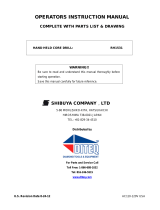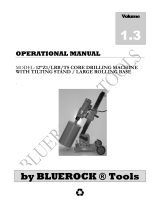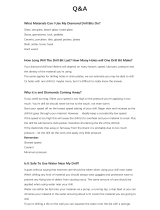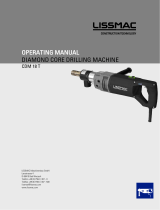Hilti 3476076 is a diamond coring machine designed for hand-held drilling in masonry using dry-cutting diamond core bits and for hand-held drilling in concrete and other mineral materials using wet-cutting diamond core bits. With the core bit diameters ranging from 25 to 132 mm (1” to 5¼") for wet drilling and 16 to 162 mm (⁵⁄₈" to 6½") for dry drilling, this device is suitable for various drilling tasks. It operates with two gears, providing speeds of 650/min for the first gear and 1,380/min for the second gear.
Hilti 3476076 is a diamond coring machine designed for hand-held drilling in masonry using dry-cutting diamond core bits and for hand-held drilling in concrete and other mineral materials using wet-cutting diamond core bits. With the core bit diameters ranging from 25 to 132 mm (1” to 5¼") for wet drilling and 16 to 162 mm (⁵⁄₈" to 6½") for dry drilling, this device is suitable for various drilling tasks. It operates with two gears, providing speeds of 650/min for the first gear and 1,380/min for the second gear.




















-
 1
1
-
 2
2
-
 3
3
-
 4
4
-
 5
5
-
 6
6
-
 7
7
-
 8
8
-
 9
9
-
 10
10
-
 11
11
-
 12
12
-
 13
13
-
 14
14
-
 15
15
-
 16
16
-
 17
17
-
 18
18
-
 19
19
-
 20
20
-
 21
21
-
 22
22
-
 23
23
-
 24
24
Hilti 3476076 is a diamond coring machine designed for hand-held drilling in masonry using dry-cutting diamond core bits and for hand-held drilling in concrete and other mineral materials using wet-cutting diamond core bits. With the core bit diameters ranging from 25 to 132 mm (1” to 5¼") for wet drilling and 16 to 162 mm (⁵⁄₈" to 6½") for dry drilling, this device is suitable for various drilling tasks. It operates with two gears, providing speeds of 650/min for the first gear and 1,380/min for the second gear.
Ask a question and I''ll find the answer in the document
Finding information in a document is now easier with AI
Related papers
-
Hilti 274935 User guide
-
Hilti DD 110-D Operating instructions
-
Hilti DD 160 User manual
-
Hilti DD 110-D User manual
-
Hilti DD 120 Operating instructions
-
Hilti 273756 User manual
-
Hilti DD 110-W Operating instructions
-
Hilti UD16 Operating Instructions Manual
-
Hilti DD 110-W Operating Instructions Manual
-
Hilti DD 110-W Operating instructions
Other documents
-
Makita DBM131 Datasheet
-
Milwaukee MXF301-2CXS-2821-22 User manual
-
Milwaukee MXF301-2CXS-MXF301-2CP User manual
-
 Shibuya RH1531 Operator's Instruction Manual
Shibuya RH1531 Operator's Instruction Manual
-
Milwaukee MX FUEL MXF DCD150 User manual
-
 Bluerock Tools 12"Z1/LRB/TS Operational Manual
Bluerock Tools 12"Z1/LRB/TS Operational Manual
-
 BLENDX FBA_bx-022 User guide
BLENDX FBA_bx-022 User guide
-
Diamond Products CB733 Operating instructions
-
 Lissmac CDM 18 T Owner's manual
Lissmac CDM 18 T Owner's manual
-
Grizzly T10537 Owner's manual



























